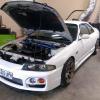r34 turbo on rb20
Announcements
-
Similar Content
-
Latest Posts
-
There's no way they left the factory like that. In R chassis there is nothing stopping the steering wheel being put on one spline out from straight, and then adjusting the steering arms to "correct" it (sort of). As well as the indicator cancelling there would also be an issue with how tight you can turn in one direction to the other. The other (less likely) possibility is that the "clock spring" (the circular electronic part that allows the wheel to turn while still having an electrical connection for horn and any other buttons like cruise) might not be in place correctly. I don't have any pics of the R33 (or Stagea) setup but there would be a circular locating tab which sits in the steering column to have it straight...if that is not seated properly then the indicators may not cancel at the right point (and, you might also get a HICAS error since it would think you are driving in circles)
-
It will mostly be bad scoring on the bores, which you can almost certainly fix by machining for oversize pistons. I have to say, I am super surprised that any standard turbos made it 35 years down the track before exploding!
-
By Peeeeetaaah · Posted
Thanks for the info mate was thinking 255/35 rears and 235/40 fronts -
What's the difference? I would have said that between the front and rear axle lines, there's no noticeable diff between a GTR and an NA 2-door.
-
It will be salvageable. It really doesn't matter what is damaged. Opening up a 30+ year old motor for a rebuild immediately means a complete rebuild of the head anyway. Damaged valves just means an opportunity to put in some nice new ones. And in the modern day, why would you not throw at least a nice set of pistons at something. And if you're doing that, why not rods, and ARP fasteners, and so on.
-



Recommended Posts
Create an account or sign in to comment
You need to be a member in order to leave a comment
Create an account
Sign up for a new account in our community. It's easy!
Register a new accountSign in
Already have an account? Sign in here.
Sign In Now